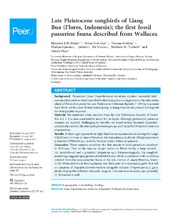| dc.contributor.author | Meijer, Hanneke | |
| dc.contributor.author | Due, Rokus Awe | |
| dc.contributor.author | Sutikna, Thomas | |
| dc.contributor.author | Saptomo, Wahyu | |
| dc.contributor.author | Jatmiko, Jatmiko | |
| dc.contributor.author | Wasisto, Sri | |
| dc.contributor.author | Tocheri, Matthew W. | |
| dc.contributor.author | Mayr, Gerald | |
| dc.date.accessioned | 2018-08-14T11:33:32Z | |
| dc.date.available | 2018-08-14T11:33:32Z | |
| dc.date.issued | 2017-08-17 | |
| dc.Published | Meijer H.J.M., Due, Sutikna T, Saptomo, Jatmiko J, Wasisto S, Tocheri MW, Mayr. Late Pleistocene songbirds of Liang Bua (Flores, Indonesia); the first fossil passerine fauna described from Wallacea. PeerJ. 2017;5:e3676 | eng |
| dc.identifier.issn | 2167-8359 | |
| dc.identifier.uri | https://hdl.handle.net/1956/18074 | |
| dc.description.abstract | Background: Passerines (Aves: Passeriformes) dominate modern terrestrial bird communities yet their fossil record is limited. Liang Bua is a large cave on the Indonesian island of Flores that preserves Late Pleistocene–Holocene deposits (∼190 ka to present day). Birds are the most diverse faunal group at Liang Bua and are present throughout the stratigraphic sequence. Methods: We examined avian remains from the Late Pleistocene deposits of Sector XII, a 2 × 2 m area excavated to about 8.5 m depth. Although postcranial passerine remains are typically challenging to identify, we found several humeral characters particularly useful in discriminating between groups, and identified 89 skeletal elements of passerines. Results: At least eight species from eight families are represented, including the Large-billed Crow (Corvus cf. macrorhynchos), the Australasian Bushlark (Mirafra javanica), a friarbird (Philemon sp.), and the Pechora Pipit (Anthus cf. gustavi). Discussion: These remains constitute the first sample of fossil passerines described in Wallacea. Two of the taxa no longer occur on Flores today; a large sturnid (cf. Acridotheres) and a grassbird (Megalurus sp.). Palaeoecologically, the songbird assemblage suggests open grassland and tall forests, which is consistent with conditions inferred from the non-passerine fauna at the site. Corvus cf. macrorhynchos, found in the Homo floresiensis-bearing layers, was likely part of a scavenging guild that fed on carcasses of Stegodon florensis insularis alongside vultures (Trigonoceps sp.), giant storks (Leptoptilos robustus), komodo dragons (Varanus komodoensis), and probably H. floresiensis as well. | en_US |
| dc.language.iso | eng | eng |
| dc.publisher | PeerJ | eng |
| dc.rights | Attribution CC BY | eng |
| dc.rights.uri | http://creativecommons.org/licenses/by/4.0 | eng |
| dc.subject | Aves | eng |
| dc.subject | Passeriformes | eng |
| dc.subject | Avifauna | eng |
| dc.subject | Passerines | eng |
| dc.subject | Wallacea | eng |
| dc.subject | Southeast Asia | eng |
| dc.title | Late Pleistocene songbirds of Liang Bua (Flores, Indonesia); the first fossil passerine fauna described from Wallacea | eng |
| dc.type | Peer reviewed | en_US |
| dc.type | Journal article | en_US |
| dc.date.updated | 2018-03-06T12:28:17Z | |
| dc.description.version | publishedVersion | |
| dc.rights.holder | Copyright 2017 The Author(s) | eng |
| dc.identifier.doi | https://doi.org/10.7717/peerj.3676 | |
| dc.identifier.cristin | 1545832 | |
| dc.source.journal | PeerJ | |

